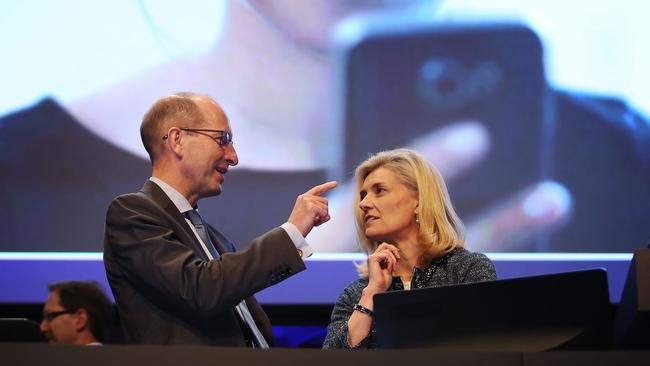AMP power shifts have always been bathed in blood
When Catherine Brenner accepted the role as chairman of AMP, it was the pinnacle of a glossy career. But she should’ve known.

When Catherine Brenner accepted, with delight, her appointment as chairman of AMP two years ago, it seemed the pinnacle of a glossy career.
But there are calls now for Brenner’s head after shocking revelations in the royal commission of clients charged fees for services they never received — which snowballed into revelations that Brenner last year sought changes to a so-called independent report on the matter destined for the securities regulator, ASIC. She has been sufficiently damaged as to make her leadership of AMP questionable, along with several executives caught up in the same story.
This week has shown that fate will have its way and in the history of the AMP it is usually safe to say that what goes up must come down.
If Brenner had perused carefully the AMP’s past before stepping forward she might have found the old adage “the triumph of hope over experience” worth pondering.
She had an MBA, she had been a corporate lawyer and successful investment banker; she was on the board of Boral and Coca-Cola Amatil and a trustee at the Opera House. She had the guru of the Australian directors’ lounge, David Gonski, at her back.
She had been on the AMP board for several years when suddenly the extremely well-regarded chairman Simon McKeon announced that he was stepping down. He cited a change in circumstances, whatever that meant.
And so, on June 24, 2016 — a perfect winter day with warm sun and 16 degrees on the pavements of central Sydney — Brenner accepted the chair. She had the crown, but the cup Brenner received was more a poisoned chalice. For two decades or more, the AMP had claimed more chairmen and chief executives than most could count.
This was a company with a history rolling in red — with tales of betrayal and cowardice, of revenge and miscalculation, of mass resignations, of harakiri in the boardroom and across the top shelf. From takeover to farewell drinks party, chairmen and chief executives had been dispatched with little more than a few years between them. Some directors had been heroes and heroines. But AMP had regularly been a bloodbath.
The late 1990s saw, in quick succession, the knifing by a chairman of the CEO, followed by the new CEO knifing the chairman, followed by the next chairman quitting early, and the new (ish) CEO knifed next. All of this came to pass as directors rose and fell and the company swirled in the mess created by AMP’s takeover of GIO and later, a non-takeover of AMP by the National Australia Bank.
George Trumbull was an American with a raucous, hard-driving style, appointed chief executive in 1994 by AMP’s smooth and polished chairman Ian Burgess — a man as low-key as Trumbull was noisy. Trumbull presided over the demutualisation of AMP and its heady stock exchange listing in 1998, and he overhauled the culture.
But it was also Trumbull who led a charge, backed by the board, to take over the GIO, with his chief financial officer Paul Batchelor running the strategy. It was a hostile bid with no due diligence and it became bitter in the dirtiest way, with two CEOs going head to head. Later, when it all went wrong with GIO reinsurance losses and the AMP share price tanking — fingers pointed every which-way; at the board, at the chairman Burgess, at Trumbull, and later, at Batchelor.
Trumbull decided to pull up stumps early, but in a moment of hubris he gave a media interview where he described the captains of industry in Australia as “freaking liars, yellow-bellied Australian cowards”, and “sons of bitches”. He agreed to be photographed wearing a huge Native American Indian headdress of startling blue feathers, keeping the feathers on even when the photographer’s camera failed and she stooped to reload. Trumbull was fired the next morning on the spot by his Burgess but he won the game in the end — after a round with the lawyers — leaving with $13 million in his pocket in early 2000.
Nine months after Trumbull was removed, AMP was in even greater turmoil. New chief executive Paul Batchelor, one of the architects of the GIO takeover strategy, was confronted with an almost $1.5 billion dollar loss related to GIO. By April 2000, the boardroom was toxic. The company was flayed over the losses and also over revelations that AMP had knocked back a takeover bid from NAB.
Burgess had met with the top tier of the NAB together with Batchelor; the whole matter had been to the AMP board.
But somehow, highly damaging, and totally wrong rumours flooded the marketplace to the effect that Burgess had been freelancing and had rejected a healthy bid without any reference to the AMP board or his CEO.
Burgess fought to save himself. He turned to Batchelor, seeking his public support and confirmation that the NAB offer had been dealt with appropriately.
Batchelor, a driving force behind the GIO bid and co-negotiator with Burgess on the NAB approach, refused any support. Three days later, the AMP boardroom was at war.
On April 3, 2000, five directors resolved to fall on their swords to stop the damage to the company: Burgess and four others. Those resigning included the scientist and former head of the CSIRO Professor Adrienne Clarke, who stunned the boardroom when she turned to Batchelor after the resignations had been delivered. In words that would ring for years she declared, “I wish this company well. But you are going to be hampered because you will be forever badged as the chief executive who did not support his chairman ... whether it’s perception or reality, it will always be with you.”
Five weeks later at the AGM, Stan Wallis was the stand-in chairman. Two years further on, Paul Batchelor’s head rolled too. In September 2002, amid reports that the markets had been misled over AMP’s disclosure about problems in its British operations, the company abruptly announced that Batchelor was leaving. Wallis would follow, announcing that he planned to stand down at the end of the year. The chief financial officer had been shuffled out a few weeks before.
If turmoil had been the company byword, so too it seemed had greed. Trumbull had left with a $13m payout; Batchelor had been torn apart not long before he was sacked after revealing that his contract allowed him to prolong for another two years 400,000 share options that were due to vest and underwater. Batchelor was fired with a $1.4m cheque delivered to his home and then set out to sue the company. It was just a few weeks after Wallis had denied to the media that he had any plans to unseat the CEO. And on it went.
Catherine Brenner is the inheritor of all of this and much more besides.
Already, her chief executive Craig Meller has brought forward his own “firing” from the end of the year to now in response to the awful rendition of failings and possible illegal activities by the company over its ASIC disclosures.
General counsel Brian Salter has stood aside while a review takes place into the way an independent report to ASIC was handled and the voluminous correspondence between AMP and the authors of that report: Salter’s old law firm Clayton Utz.
Meller will not be the last to go. If Brenner survives to see AMP through the worst of this, those involved in some of the unconscionable behaviour revealed before Justice Kenneth Hayne will no doubt find their desks emptied. People are burning from the feet up.
In the past, AMP has had a propensity to shoot the CEO first and then turn on the chairman. Sometimes, however, it has shot the chairman and laid in wait for the new CEO.
The first shots in the 2018 drama have already been fired.


